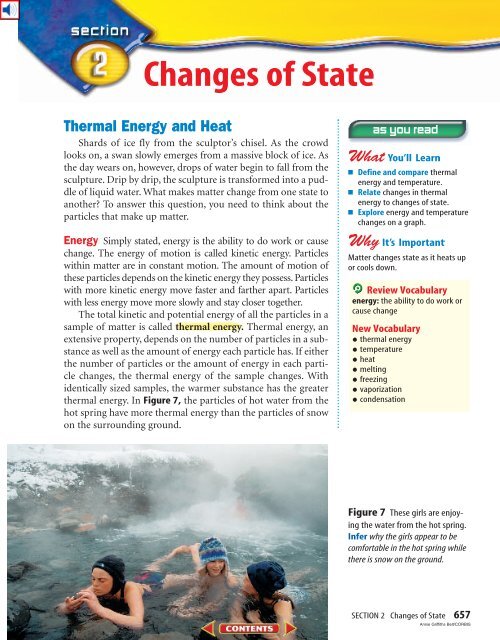You also want an ePaper? Increase the reach of your titles
YUMPU automatically turns print PDFs into web optimized ePapers that Google loves.
Changes <strong>of</strong> State<br />
Thermal Energy and Heat<br />
Shards <strong>of</strong> ice fly from the sculptor’s chisel. As the crowd<br />
looks on, a swan slowly emerges from a massive block <strong>of</strong> ice. As<br />
the day wears on, however, drops <strong>of</strong> water begin to fall from the<br />
sculpture. Drip by drip, the sculpture is transformed into a puddle<br />
<strong>of</strong> liquid water. What makes matter change from one state to<br />
another? To answer this question, you need to think about the<br />
particles that make up matter.<br />
Energy Simply stated, energy is the ability to do work or cause<br />
change. The energy <strong>of</strong> motion is called kinetic energy. Particles<br />
within matter are in constant motion. The amount <strong>of</strong> motion <strong>of</strong><br />
these particles depends on the kinetic energy they possess. Particles<br />
with more kinetic energy move faster and farther apart. Particles<br />
with less energy move more slowly and stay closer together.<br />
The total kinetic and potential energy <strong>of</strong> all the particles in a<br />
sample <strong>of</strong> matter is called thermal energy. Thermal energy, an<br />
extensive property, depends on the number <strong>of</strong> particles in a substance<br />
as well as the amount <strong>of</strong> energy each particle has. If either<br />
the number <strong>of</strong> particles or the amount <strong>of</strong> energy in each particle<br />
changes, the thermal energy <strong>of</strong> the sample changes. With<br />
identically sized samples, the warmer substance has the greater<br />
thermal energy. In Figure 7, the particles <strong>of</strong> hot water from the<br />
hot spring have more thermal energy than the particles <strong>of</strong> snow<br />
on the surrounding ground.<br />
■ Define and compare thermal<br />
energy and temperature.<br />
■ Relate changes in thermal<br />
energy to changes <strong>of</strong> state.<br />
■ Explore energy and temperature<br />
changes on a graph.<br />
<strong>Matter</strong> changes state as it heats up<br />
or cools down.<br />
Review Vocabulary<br />
energy: the ability to do work or<br />
cause change<br />
New Vocabulary<br />
• thermal energy<br />
• temperature<br />
• heat<br />
• melting<br />
• freezing<br />
• vaporization<br />
• condensation<br />
Figure 7 These girls are enjoying<br />
the water from the hot spring.<br />
Infer why the girls appear to be<br />
comfortable in the hot spring while<br />
there is snow on the ground.<br />
SECTION 2 Changes <strong>of</strong> State 657<br />
Annie Griffiths Belt/CORBIS

















